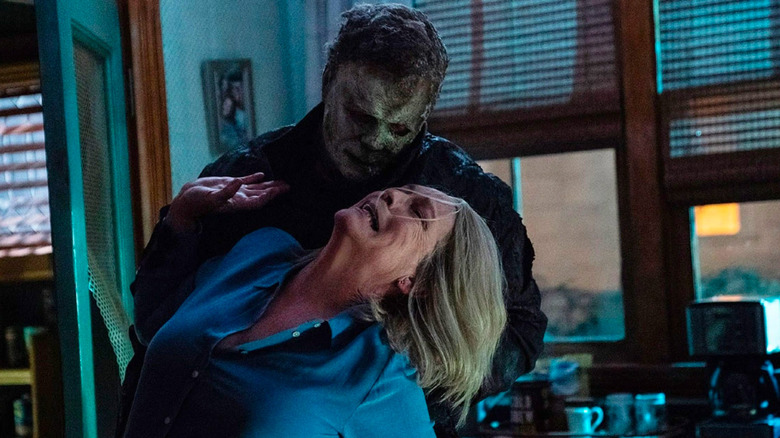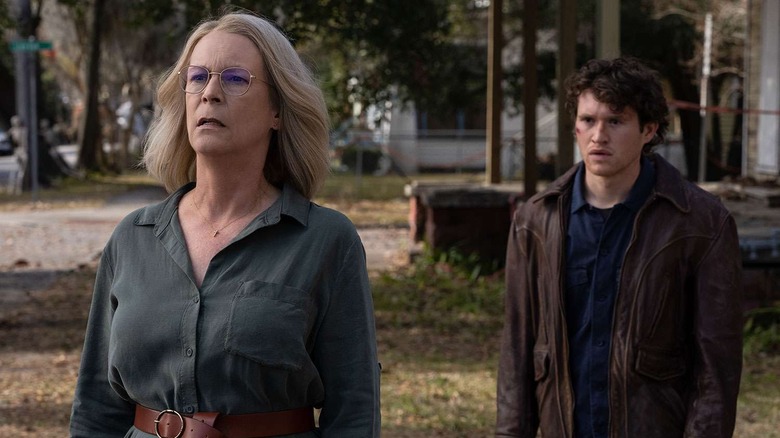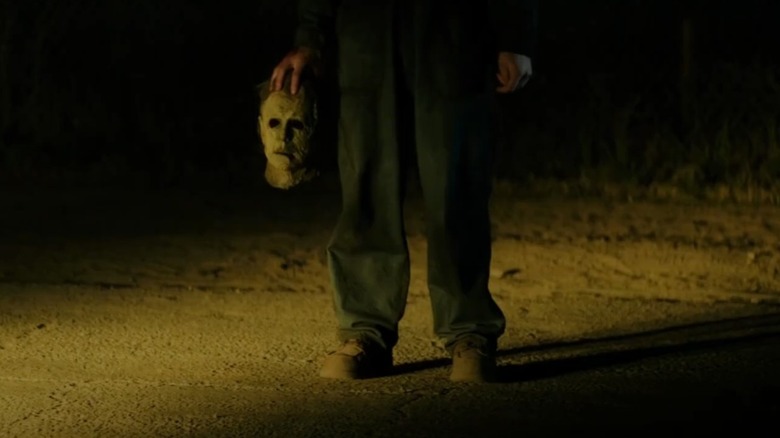The Original Halloween Ends Ending Left Laurie Strode In A Very Dark Place
We may receive a commission on purchases made from links.
Spoilers for "Halloween Ends" follow.
The "Halloween Ends" defender has logged on. I know a lot of people hold David Gordon Green's trilogy conclusion in low-regard, but I firmly believe it's one of the most interesting "Halloween" sequels ever made. Green and company take some mighty big swings, telling a story not so much about Michael Myers and Laurie Strode as it is about evil as a kind of infectious disease, almost surely a reaction to the COVID-19 era. The story, for those of you who forgot, finds Laurie Strode (Jamie Lee Curtis) trying to live a normal life following the return of Michael Myers and the death of her daughter Karen (Judy Greer). As for old Mikey, aka The Shape, he's retreated underground, still healing from wounds inflicted upon him by an angry mob of Haddonfieldians.
In the midst of all this is the story of Corey Cunningham (Rohan Campbell), a loser and loner who has the misfortune of being involved in the accidental death of a child. Corey has become the town outcast, and yet he catches the eye of Laurie's granddaughter Allyson (Andi Matichak). The two enter into a kind of doomed romance, and while all that unfolds, Corey runs into Michael Myers. The Shape attacks Corey and seemingly transfers part of his evil essence into the young man. As a result, Corey becomes a serial killer and even dons the infamous Shape mask.
Eventually, Laurie catches on to the fact that Corey is bad news. In the film's big climax, Laurie and Corey battle at Laurie's home. Corey is defeated and stabs his own throat to frame Laurie, just as Allyson shows up. She thinks her grandmother has murdered her boyfriend and flees. Enter Michael Myers, who shows up at Laurie's house, kills Corey, and takes back his mask. A final confrontation ensues between Laurie and The Shape, Allyson returns to help, and Michael is eventually killed, his throat slit. Then, Laurie and the rest of Haddonfield gather for a procession that ends with Michael's dead body being tossed into a car crusher. Michael Myers is no more.
But the ending of the film could've gone a much, much different way.
Evil energy
The final moments of "Halloween Ends" are peaceful, and even hopeful. Allyson leaves town to start a new life, Michael Myers and Corey Cunningham are both defeated, and Laurie Strode looks ready to put her traumatic past behind her once and for all. But according to Abbie Bernstein's new book "Halloween: The Official Making of Halloween, Halloween Kills and Halloween Ends," the "Halloween Ends" ending was originally much, much darker.
As the book tells it, the basic set-up of the finale was the same, with Corey and then the real Michael Myers showing up to battle Laurie. Eventually, Laurie manages to kill the Shape, but as she does, "Michael completely transfers his energy to Laurie as he dies." Yes, that's right — the evil energy that makes Michael Myers was transferred into Laurie Strode. Realizing the darkness inside her now, Laurie sends Allyson away and "literally shuts her door on the world to prevent the darkness she has taken in from ever coming out."
As Jamie Lee Curtis puts it, "I don't think there was ever a feeling that Laurie would act out as Michael ... It was simply that she had the capability in her now because she had killed. The only way to keep everyone safe was for her to isolate."
As for Michael, his body was burned in a crematorium instead of being obliterated in a car crusher.
Larger and slightly less bleak
To be blunt, this ending stinks. There's no closure; no catharsis. Instead of giving Laurie Strode a much-needed happy ending, we're left with the character pretty much right back where she started in 2018's "Halloween" — alone and cut off from the world. Thankfully, everyone involved with the film realized the alternate ending was a bad one. As Bernstein writes, "[A]fter a first cut of Halloween Ends was completed, the creative team ... decided that the finale should be both larger and slightly less bleak."
Again, I am a "Halloween Ends" defender. And I think the film's theatrical ending, where Laurie gets to seemingly move on with her life — complete with a series of shots of empty, well-lit, peaceful rooms to contrast with the ending shots of dark, ominous rooms from the finale of the original "Halloween" — is kind of stunning in its beauty. It's bold, it's effective, and it's risky. It's also a hell of a lot better than "Michael Myers passes his evil energy into Laurie Strode." So I sure am glad that cooler heads prevailed and they avoided making a big, big mistake.


